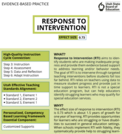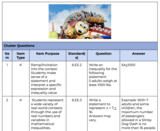
This resource is a collection of ideas for classroom arrangement, management systems, and classroom libraries.
- Subject:
- Professional Learning
- Material Type:
- Reading
- Provider:
- Utah State Board of Education
- Date Added:
- 06/08/2023

This resource is a collection of ideas for classroom arrangement, management systems, and classroom libraries.

Provides an overview of research on reading engagement and motivation. Works as a brief and good introduction to this topic.

This document provides the old reading standards aligned with the new to show the reorganization of the ELA reading standards.

A brief overview of this topic (disciplinary literacy) including links to additional professional development and classroom resources.

The focus of the Recognize Small Quanitities without Counting (Subitizing) intervention is strategies for recognizing quantities one to three objects without counting.

Download, complete, and submit this form for Evidence of Preparation and Planning.

This page includes links to the varied Tiers of instruction and defines each one.

Response to Intervention (RTI) aims to identify students who are making inadequate progress and provide them evidence based support to address learning and/or behavior needs. The goal of RTI is to intervene through targeted teaching interventions before students fall too far behind. RTI relies on teachers using data to measure student progress and provide just in time support to learners. RTI is not a special education program, but can help educators identify struggling learners who may qualify for special education services.

Restaurant Grand Opening: Standard 7.SP.6 Approximate the probability of a chance event by collecting data on the chance process that produces it and observing its long-run relative frequency and predict the approximate relative frequency given the probability.
This formative assessment exemplar was created by a team of Utah educators to be used as a resource in the classroom. It was reviewed for appropriateness by a Bias and Sensitivity/Special Education team and by state mathematics leaders. While no assessment is perfect, it is intended to be used as a formative tool that enables teachers to obtain evidence of student learning, identify assets and gaps in that learning, and adjust instruction for the two dimensions that are important for mathematical learning experiences (i.e., Standards for Mathematical Practice, Major Work of the Grade).

Content review is a deep dive into the resources from the learner’s perspective to determine suitability and accessibility of the materials for a group of learners based on the learners’ analysis and the rigor of the standard(s). Instructional trouble spots are identified through the content review. Instructional trouble spots are where students may have difficulties in learning. The teacher needs to address and plan for trouble spots in the content area and instruction.

Ride on Slinky Dog Dash: Standard 6.EE.5 Understand solving an equation or inequality as a process of answering a question: which values from a specified set, if any, make the equation or inequality true? Use substitution to determine whether a given number in a specified set makes an equation or inequality true.
This formative assessment exemplar was created by a team of Utah educators to be used as a resource in the classroom. It was reviewed for appropriateness by a Bias and Sensitivity/Special Education team and by state mathematics leaders. While no assessment is perfect, it is intended to be used as a formative tool that enables teachers to obtain evidence of student learning, identify assets and gaps in that learning, and adjust instruction for the two dimensions that are important for mathematical learning experiences (i.e., Standards for Mathematical Practice, Major Work of the Grade).

This resource is a free, downloadable audio file of short music clips to use for instruction.

This resource is a free, downloadable audio file of short music clips to use for instruction.

An excerpt from the online open access source Writing and Critical Thinking Through Literature, this chapter explores how to conduct a literary analysis of creative nonfiction.

In this Voices from the Middle article, Kristen Robbins draws on her middle-school teaching experiences to share with teachers some strategies for responding to student writing throughout the writing process rather than waiting until the end to give grades to student writing products.

Information about rock falls in Utah.

This resource is a free, downloadable audio file of short music clips to use for instruction.

This resource is a free, downloadable audio file of short music clips to use for instruction.

In this Writers Who Care blog post, Kara Douma shares how a K-W-L strategy for student learning can be deepened by thinking of how to activate meaningful reflection. Teachers may find this resource useful as they consider how to deepen reflective practices in their own classrooms.

This resource is a free, downloadable audio file of short music clips to use for instruction.